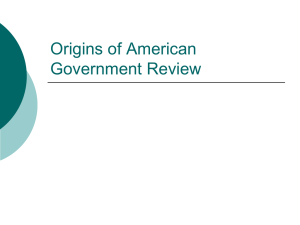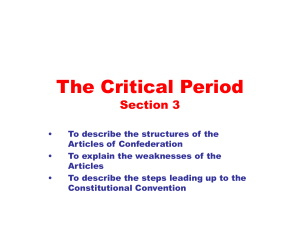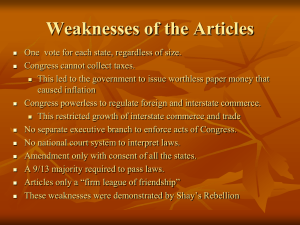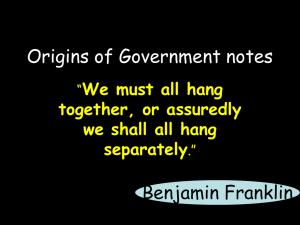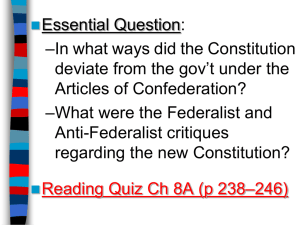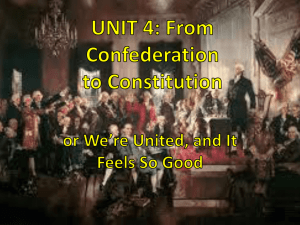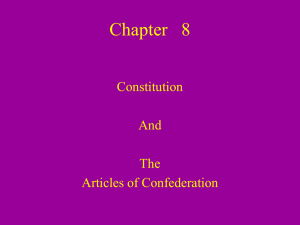Constitution
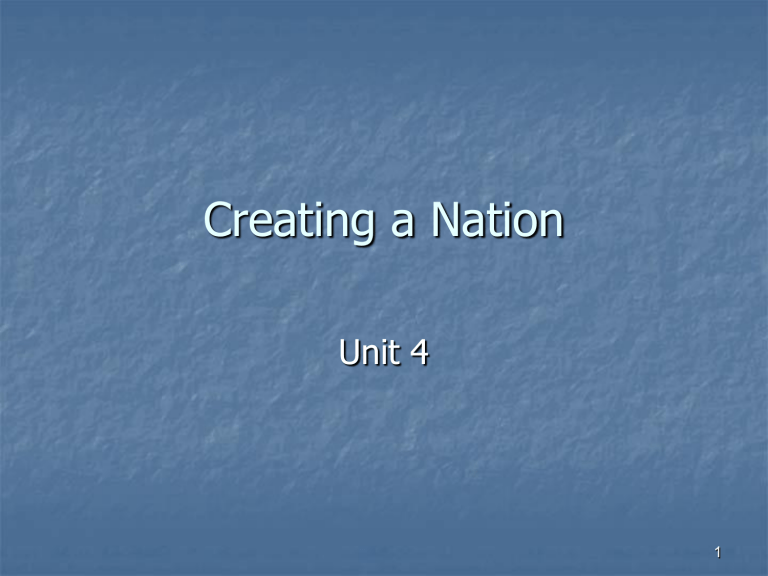
Creating a Nation
Unit 4
Day 1
The Articles of Confederation, our First
Constitution
1. The Articles of Confederation provided a framework for a national government.
2. The Articles of Confederation was our country’s first constitution, or plan of government.
Play clip 1, Overview
After the Revolution
Revolutions are difficult-overthrowing Great
Britain wasn’t easy at all for the American colonists- but building a strong nation was much harder.
The end of the war brought liberty , but America also faced problems.
1. The Continental army was unfed, undersupplied, and unpaid, which led to near mutiny.
2. With the Revolution over, a massive debt of $27,000,000.00 had to be paid in gold.
Play clip 2, After the Revolution
UNITED states?
In 1776 as states began to write their state constitutions, The Second Continental Congress began to write a national constitution.
However, writing this constitution was very difficult because in 1776 few Americans considered themselves citizens of one nation.
Instead, they felt loyalty to their own states.
The Articles of Confederation are ratified
Although states seemed unwilling to turn over much power to the national government, the Articles of
Confederation were drafted in late 1777 to administer the nation during the Revolutionary war.
The Articles then went to the states for the required ratification by all thirteen states. After ratification in
1781, the Articles became the first Constitution of the
United States.
Ratification was delayed because of a dispute among the states over western land claims by some states.
Maryland would not ratify the Articles until all lands between the Appalachian Mountains and the Mississippi
River became public land.
Who wrote the Articles?
1.
2.
3.
4.
5.
The main author of the Articles, John Dickinson, called our first constitution a “firm league of friendship” among the states.
It established a loose alliance of states rather than a strong central government.
Dickinson and other writers feared a strong central government because of their experience with the British
King and the Parliament.
They purposefully created a weak national government under the Articles.
Under the Articles the Continental Congress became the
Confederation Congress, a national lawmaking body in which each state had one vote.
National Government Under the Articles of
Confederation
CONGRESS COULD CONGRESS COULD NOT
Maintain an ________ and navy
Declare ______and peace
Make ________s and alliances with other nations
Borrow ___________
Establish a ___________ _
_________________________
Issue ___________
Levy ______________on states
Prevent states from issuing their own
________________
Elect a _______________________
Amend the Articles without the consent of all
__________states
Require state to provide money for running the
__________________________
_________________________________
Regulate ________________ and commerce
Manage affairs with _____________________
_________________________________
Enforce a law in any ___________ that did not accept that law
National Government Under the Articles of
Confederation
CONGRESS COULD CONGRESS COULD NOT
Maintain an army and navy
Declare war and peace
Make treaties and alliances with other nations
Borrow money
Levy taxes on states
Prevent states from issuing their own money
Elect a President
Amend the Articles without the consent of all 13 states
Require state to provide money for running the national government
Establish a post office
Regulate trade and commerce Issue money
Manage affairs with Native Americans
Enforce a law in any state that did not accept that law
Play Clip 3, Articles of Confederation
Obvious Weaknesses of the
Articles of Confederation
1.
Most power held by
________________
2.
_____________ branch of government
3.
Legislative branch has
________________ powers
4.
No
_________________________ branch
5.
No
_________________________ system
6.
No system of
_______________________ and
_______________________
Weaknesses of the
Articles of Confederation
END Day 1
Laws Passed Under the Articles
Land Ordinance of 1785
Northwest Ordinance of 1787
The Confederation Congress passes the LAND Ordinance of 1785
Congress passed Land Ordinance of
1785 to raise money to pay debts.
Ordinance provided for surveying and dividing western lands.
Land was split into townships.
Each township was divided into sections for sale to the public.
The Confederation Congress
Establishes the Northwest Territory
Congress passed Northwest
Ordinance of 1787.
Established Northwest Territory and a system for creating new states
Included what are now the states of
Ohio, Indiana, Michigan, Illinois, and
Wisconsin
Required the provision of public education and banned slavery
The Land Ordinance of 1785 and the
Northwest Ordinance of 1787
The Impact of Adding New States
END Day 2
Day 3
The New Nation Faces Challenges
• Under the Articles of Confederation the United
States was an unstable nation.
• Even as America expanded westward, it continued to have problems with other nations.
The United States had Difficulties with other Nations
Britain refused to turn over its forts in
U.S. territory to American control.
Britain did not allow American ships to trade with the British West Indies
Britain imposed high tariffs on American merchants.
Spain Closed the Lower Mississippi to Shipping
In 1784 Spanish officials closed the lower
Mississippi River to U.S. shipping.
Western farmers and merchants were furious because they used the Mississippi to send goods to eastern and foreign markets.
The Confederation Congress tried to work out an agreement with Spain, but the plan did not receive a majority vote in Congress.
The plan could not be passed, so Spain broke off the negotiations.
The United States Faces Trade
Barriers
Impact of Closed Markets
Closing markets in the British West Indies caused
American exports to drop.
Cheap British goods flowed into the United States.
The Confederation Congress had no authority to pass tariffs, or order states to pass tariffs, to help correct unequal trade with Britain.
States worked independently to increase their own trade instead of improving the situation for the whole country.
End Day 3
Day 4
A Failing Economy
History: Benchmark F: Indicator 5b: Creating a stable economic system and Indicator 5c: Dealing with war debts.
Economics: Benchmark C: Indicator 4: Explain how lack of power to regulate the economy contributed to the demise of the Articles of
Confederation and the creation of U.S.
Constitution.
Government: Benchmark B: Indicator 3a: Shay’s
Rebellion, Indicator 3b: Economic instability,
Indicator 3c: Government under the Articles of
Confederation
Internal Economic Problems
Plagued the New Nation
The Confederation Congress had no power to regulate interstate
commerce, making trade difficult across state lines.
Inflation was a problem in many states, which struggled to pay off war debts by printing money.
Money was not backed by gold or silver, so it was worth less.
Loss of trade with Britain combined with inflation caused an economic depression.
Depression is a period of low economic activity combined with a rise in unemployment.
Farmers Face Hardships Under the Articles
Farmers experienced extreme hardship after the war.
Throughout the war, demand for food had increased.
To keep up with this demand, many farmers had borrowed money from banks to buy more land and equipment.
However, after the war the demand for farm products decreased.
Farmers grew more food than they could sell and then could not repay the money they had borrowed.
The banks began taking the farmers’ land away to pay their debts.
When Spain closed the port of New Orleans, farmers could no longer ship their goods for export.
Shays’ Rebellion
Daniel Shays led Massachusetts farmers in a revolt over high taxes and farm foreclosures in August 1786.
The Confederation Congress had no power to put down
Shay’s Rebellion
Shays’s Rebellion was put down by state militia in
January 1787.
Tried to force the shutdown of the Supreme Court in
Massachusetts
No one’s property could be taken to pay off debts if the court was closed.
Many citizens agreed with the farmers and their cause.
State officials freed most of the farmers.
Causes
Shays’s
Rebellion
Effect
Constitutional
Convention
Many Americans Called for Changes in the National Government
Shays’s Rebellion showed the weaknesses of the Articles of Confederation, since the Confederation Congress could not respond to Massachusetts’s call for help.
People saw that the ideals of liberty were not protected.
People called for a stronger central government that could protect the nation in times of crisis.
The Virginia legislature called for a national conference to change the Articles of Confederation.
The Confederation Congress was called together in May
1787 in Philadelphia to revise the Articles.
End Day 4
Begin Day 5
Day 5
Creating the Constitution
A new constitution provided a framework for a stronger national government.
History: Benchmark F: Indicator 6: Explain the challenges in writing and ratifying the U.S. Constitution including: a: Issues debated during the convention resulting in compromises (i.e., the Great
Compromise, the Three-Fifths Compromise and the compromise over the slave trade).
A New Constitution
Delegates realized the Articles of
Confederation had too many weaknesses
Each state sent delegates to the
Constitutional Convention to write an entirely new constitution
Play Clip 4, Constitutional
Convention
The Constitutional Convention
Met to Improve the Government of the United States
Constitutional Convention held in
Philadelphia in 1787.
Convention leaders included James Madison,
Benjamin Franklin, and George Washington.
Because of James Madison’s many contributions to the formation of the U.S. Constitution, he is called the Father of the Constitution
Play Clip 5, Great Men of the
Constitutional Convention
The Issue of Representation Led to the Great Compromise
Virginia Plan (large state plan)- representation was based on POPULATION (written by James Madison)
New Jersey Plan (small state plan)- gave each state an EQUAL number of votes
Great Compromise resolved issue with a two-house legislature (bicameral)
A lower house—the House of Representatives—provided for representation based on state POPULATION.
An upper house—the Senate—provided for two representatives from each state. (EQUAL representation)
Great Compromise
END Day 5
Day 6
How Would Slaves be Counted for Representation?
Debate Over Slavery Led to the Three-Fifths Compromise.
The South
Wanted slaves to be counted as part of their population for representation but NOT taxation
The North
Wanted slaves counted only to determine taxes but not for representation
Three-Fifths Compromise
Resolved differences by counting each slave as three-fifths of a person for taxation and representation
The U.S. Constitution Created
Federalism and a Balance of
Power
Ensured popular sovereignty: idea that political authority resided in the people.
Provided for federalism: sharing of power between states and federal government.
Required states to obey authority of the federal government.
Gave states control over functions not assigned to the federal government.
Slave Trade
Some delegates believed slavery was wrong and the slave trade should be banned. Many southern delegates said that they would leave the Union if the
Constitution immediately ended the slave trade.
Northerners agreed that Congress could not outlaw the slave trade for 20 years.
Checks and Balances
Constitution designed to balance power between three branches of government
End Day 6
Day 7
History:
Benchmark F:
Indicator 6b: The
Federalist/Anti-Federalist debate and
6c: The debate over a Bill of
Rights.
Federalists and Antifederalists engaged in debate over the new Constitution.
Federalists
Supported Constitution
Desired strong central government
Liked balance of powers in
Constitution
Made speeches and pamphlets advocating change in government
Antifederalists
Opposed Constitution
Feared central government would be too powerful
Concerned about lack of guarantee of individual rights
George Mason became
Antifederalist over rights issue
The
Federalist Papers
Played an
Important Role in the Fight for
Ratification of the Constitution
Federalist Papers: series of essays supporting the Constitution.
Written anonymously by Alexander Hamilton, John Jay, and James
Madison.
Federalist Papers argued that new federal government would not overpower states.
Widely reprinted in newspapers around the country; influenced the
Constitution debate.
Battle for Ratification
9 states needed to ratify the Constitution.
All states except Rhode Island held ratification conventions for citizens to discuss and vote on the Constitution.
Delaware was the first state to ratify, in 1787, and Rhode Island was the last, in 1790.
New York and Virginia debated over ratification, but finally ratified.
Political leaders knew these states were important, since
Virginia had the largest population in the nation and New York was an important center for business and trade.
Ten Amendments were Added to the
Constitution to Provide a Bill of
Rights to Protect Citizens
Several states ratified the Constitution only after the promise of a bill protecting individual rights would be added to the Constitution
The NEW Congress under the NEW Constitution responded by:
Passing a Bill of Rights to be added to the Constitution as amendments.
The Bill of Rights became the first ten amendments to the
Constitution upon ratification by the states in December 1791.
Gave a clear example of how to amend the Constitution to fit the needs of a changing nation.
Flexibility of the Constitution has allowed it to survive for over
200 years.
